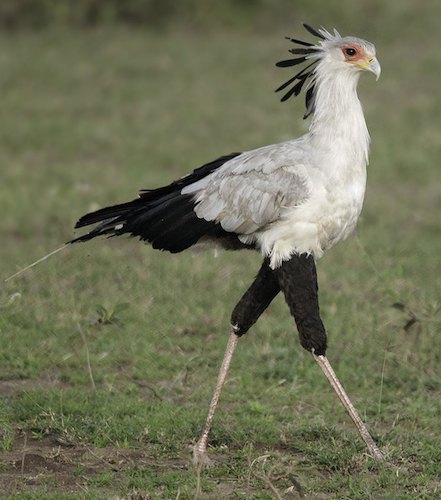Sagittariidae – Secretarybird

The Sagittariidae is a family with just one member, the Secretarybird Sagittarius serpentarius, which is a very large, mostly terrestrial bird of prey, endemic to Africa. It is usually found in the open grasslands and savannah of the sub-Saharan region. Although a member of the order Accipitriformes, which also includes many other diurnal raptors such as kites, hawks, vultures, and harriers, it is given its own family.
The secretary bird is instantly recognisable as a very large bird with an eagle-like body on crane-like legs which increases the bird’s height to as much as 1.3m. It has an eagle-like head with a hooked bill, but has rounded wings. Height can range from 90cm to 137cm. The total length from 112cm to 152cm and the wingspan betwen 191cm and 220cm. Its body mass can range from 2.3kg to 5kg with 20 birds from southern Africa found to weigh an average of 4.02kg. Its tarsus averages 31cm and the tail is 57cm to 85cm, both factor into making them both taller and longer than any other species of raptor. The neck is not especially long, and can only be lowered down to the inter-tarsal joint, so birds reaching down to the ground or drinking must stoop to do so.
From a distance or in flight it resembles a crane more than a bird of prey. The tail has two elongated central feathers that extend beyond the feet during flight, as well as long flat plumage creating a posterior crest. Secretary bird flight feathers and thighs are black, while most of the coverts are grey with some being white. Sexes look similar to one another as the species exhibits very little sexual dimorphism, although the male has longer head plumes and tail feathers. Adults have a featherless red face as opposed to the yellow facial skin of the young.
Unlike most birds of prey, the secretary bird is largely terrestrial, hunting its prey on foot. Adults hunt in pairs and sometimes as loose familial flocks, stalking through the habitat with long strides. Prey may consist of insects, mammals ranging in size from mice to hares and mongoose, crabs, lizards, snakes, tortoises, young birds, bird eggs, and sometimes dead animals killed in grass or bush fires. Larger herbivores are not generally hunted, although there are some reports of secretary birds killing young gazelles and cheetah cubs. The importance of snakes in the diet has been exaggerated in the past, although they can be locally important and venomous species such as adders and cobras are regularly among the types of snake preyed upon.
Secretarybirds associate in monogamous pairs. During courtship, they exhibit a nuptial display by soaring high with undulating flight patterns and calling with guttural croaking. Males and females can also perform a grounded display by chasing each other with their wings up and back, much like the way they chase prey. They usually mate on the ground. They will stay close to their mate even if their chick has already left.
This family consists of just one species, which is:
Secretary Bird Sagittarius serpentarius
-
Secretarybird Sagittariidae
IUCN Species Status -
Secretarybird Sagittariidae
Species AccountSound archive and distribution map. -
Secretarybird Sagittariidae
Species AccountSecretarybirds specialize in stomping their prey until the prey is killed or immobilized.
-
Number of bird species: 1
